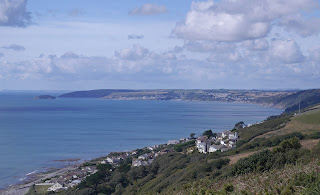Looking back towards Portwrinkle
We had ended yesterday's walk at the Portwrinkle car park, so today's leg saw us descending the hill into the tiny village and passing the incredibly small harbour (see above). I have never seen a smaller one, but we did see a boat enter and land, so it is clearly still in use. There now began a long climb, briefly on a road and then on a grassy track.
This climbed quite steadily, but we were pleased to see a number of butterflies, notably a large number of Small Coppers. This one offered an unusual view of the underwings with a little bit of upper wing as well.
I saw a yellow butterfly as well which I think was a Clouded Yellow, but could I suppose have been a Brimstone. The grassy cliffs offered a nice view over the shoreline, with an isolated rock, which I think is the Long Stone, prominent ahead.
From a bit higher up there was another fine view of the east side of Whitsand Bay, back to Rame Head where we started yesterday's walk.
After some gentle ups and downs, we reached the highest point on this section of coast and soon had a fine view of Downderry, our next destination. I was a bit surprised to find that the highest point was only about 140m.
We descended to join the road into Downderry and turned left by the school to take the beach route to Seaton (the other alternative is to continue on the road). It isn't the most beautiful beach you will ever see, but from our experience so far it is quite unusual to walk along a beach as part of the coast path - the other examples which come to mind are Studland, right at the start, and Lulworth Cove.
Downderry beach does feature an unusual mix of grey and red stone and lots of very pretty pebbles. Here is a view towards Seaton, on the right, and Looe island one the far left.
After a very pleasant stroll along the beach, I followed the sea wall round into Seaton (Ange stayed on the beach) and was thrilled to see a couple of Clouded Yellows, which this time I could definitively identify. This is my third sighting in the last few weeks. Yet again I could not manage a photo however.
We stopped briefly at the cafe in Seaton, a pleasant spot, and puzzled over a line of substantial houses which seemed to have been recently built just in from the cove. Who were they for?
We then climbed up the long, steep Looe Hill out of Seaton and were dismayed to find that where you should off the road to take a path to the coast, there was a sign saying that the Coast Path was closed because of active landslips. We plodded on up the hill, noticing some substantial houses and concluding that this must be a desirable residential district. This view was reinforced when we saw a sign pinned to a post requesting help with a lost peahen which "answers to the name of Jubilee".
The hill peaks at a trig point 155m above sea level. The road continues along a high ridge past the Monkey Sanctuary to reach Bay View Farm. Here we made a little foray out on the headland above Bodigga Cliff, the end of the closed section of path. A pleasant grassy picnic area offered a closer view of Looe Island, with glimpses of the town to the right.
The next section, through Milendreath and Plaidy was not too much fun. Mainly residential, mainly road and with an excessive amount of ascent and descent. We were pleased to finally reach a high point offering a view over the beach at East Looe.
The path goes briskly through the town, but we diverted to see one of its old buildings, the Old Guildhall of about 1500, now a museum.
Along Fore St, the main street, there are number of old houses including some nice half timbered ones with early 17th century dates on them. The most dramatic is the new Guildhall, which looks late Victorian, but I have so failed to turn up any information about it - Pevsner doesn't even mention it.
To me, the two most striking things about Looe are firstly that its original core was clearly planned: the five narrow parallel streets nearest the sea. And secondly, that because it remains a working fishing port, the river frontage is still occupied by fishing operations and associated buildings, which gives the town a curiously enclosed, almost claustrophobic, character.
It was low water when we arrived, so I will end with a more atmospheric view taken in the golden hour after sunset.
Conditions: warm, sun, clouds.
Distance: 7.6 miles.
Map: Explorer 108 (Lower Tamar Valley and Plymouth) and 107 (St Austell and Liskeard).
Rating: Three and half stars. Seaton to Looe was a bit grim.











No comments:
Post a Comment